
The term Pool of Siloam refers to a number of rock-cut pools, located outside the walls of the Old City of Jerusalem to the southeast. The pools were fed by the waters of the Gihon Spring, carried there by the Siloam Tunnel.

The City of David, known locally mostly as Wadi Hilweh, is the name given to an archaeological site considered by most scholars to be the original settlement core of Jerusalem during the Bronze and Iron Ages. It is situated on southern part of the eastern ridge of ancient Jerusalem, west of the Kidron Valley and east of the Tyropoeon Valley, to the immediate south of the Temple Mount.
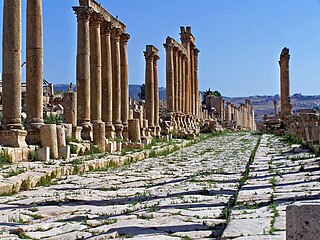
A cardo was a north–south street in ancient Roman cities and military camps as an integral component of city planning. The cardo maximus, or most often the cardo, was the main or central north–south-oriented street.

Gezer, or Tel Gezer, in Arabic: تل الجزر – Tell Jezar or Tell el-Jezari is an archaeological site in the foothills of the Judaean Mountains at the border of the Shfela region roughly midway between Jerusalem and Tel Aviv. It is now an Israeli national park. In the Hebrew Bible, Gezer is associated with Joshua and Solomon.
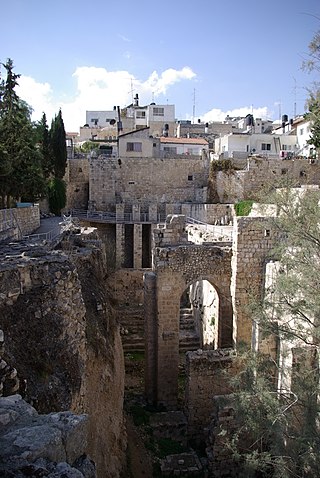
The Pool of Bethesda is referred to in John's Gospel in the Christian New Testament, in an account of Jesus healing a paralyzed man at a pool of water in Jerusalem, described as being near the Sheep Gate and surrounded by five covered colonnades or porticoes. It is also referred to as Bethzatha. It is now associated with the site of a pool in the current Muslim Quarter of the city, near the gate now called the Lions' Gate or St. Stephen's Gate and the Church of St. Anne, which was excavated in the late 19th century.
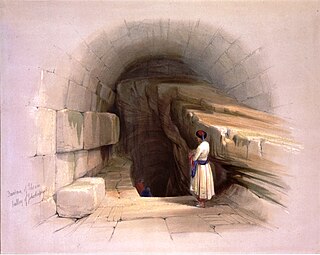
Gihon Spring or Fountain of the Virgin, also known as Saint Mary's Pool, is a spring in the Kidron Valley. It was the main source of water for the Pool of Siloam in Jebus and the later City of David, the original site of Jerusalem.

The newer Siloam Tunnel, also known as Hezekiah's Tunnel, is a water tunnel that was carved within the City of David in ancient times, now located in the Palestinian neighborhood of Silwan in East Jerusalem. Its popular name is due to the most common hypothesis that it dates from the reign of Hezekiah of Judah, late 8th and early 7th century BC, and corresponds to the "conduit" mentioned in 2 Kings 20 in the Hebrew Bible. According to the Bible, King Hezekiah prepared Jerusalem for an impending siege by the Assyrians, by "blocking the source of the waters of the upper Gihon, and leading them straight down on the west to the City of David". By diverting the waters of the Gihon, he prevented the enemy forces under Sennacherib from having access to water. An older water system, sometimes called the Siloam Channel, partly fulfilled a similar purpose and dates back to the Canaanites.
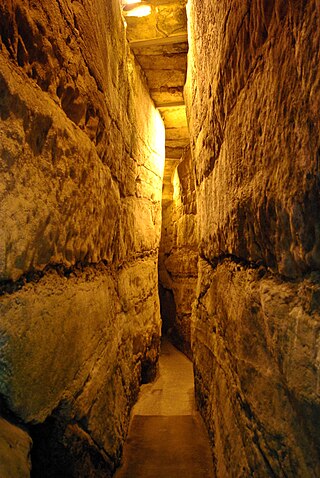
The Western Wall Tunnel is a tunnel exposing the Western Wall slightly north from where the traditional, open-air prayer site ends and up to the Wall's northern end. Most of the tunnel is in continuation of the open-air Western Wall and is located under buildings of the Muslim Quarter of the Old City of Jerusalem. While the open-air portion of the Western Wall is approximately 60 metres (200 ft) long, the majority of its original length of 488 metres (1,601 ft) is hidden underground. The tunnel allows access to the remainder of the Wall in a northerly direction.
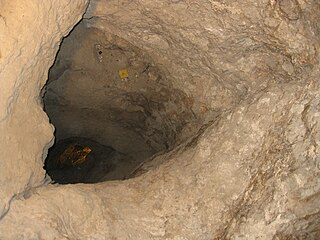
Warren's Shaft is a vertical shaft next to the Gihon Spring, the main source of water of Bronze and Iron Age Jerusalem, discovered in 1867 by British engineer, archaeologist and military officer Charles Warren. The term is currently used in either a narrower or a wider sense:

Nahman Avigad, born in Zawalow, Galicia, was an Israeli archaeologist.
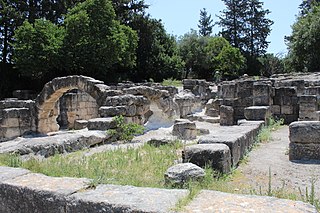
Beit She'arim, also Besara, was a Jewish village located in the southwestern hills of the Lower Galilee, during the Roman period, from the 1st century BCE to the 3rd century CE. At one point, it served as the seat of the Sanhedrin, the Judean Supreme Court.
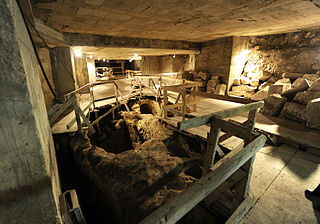
Siebenberg House is an underground archaeology museum, located below a house, in the Jewish Quarter of the Old City of Jerusalem.

The stepped street, as it is known from academic works, or the Jerusalem pilgrim road as it has been dubbed by the Ir David Foundation, is the early Roman period street connecting the Temple Mount from its southwestern corner, to Jerusalem's southern gates of the time via the Pool of Siloam. The stepped street was built at the earliest during the 30s CE, with the latest coin found under the pavement dating to 30–31 CE, during the governorship of Pontius Pilate of New Testament fame.
The Jerusalem Water Channel is a central drainage channel of Second Temple Jerusalem, now an archaeological site in Jerusalem. It is a large drainage tunnel or sewer that runs down the Tyropoeon Valley and once drained runoff and waste water from the city of Jerusalem. The excavators, Ronny Reich and Eli Shukron, date it to the later part of the Second Temple period. According to Leen Ritmeyer, the drain is mainly of Hasmonean age, with the exception of a bypass section near the southeast corner of the Temple Mount, which is Herodian.
Eli Shukron is an Israeli archaeologist employed by the Israel Antiquities Authority. He has made several significant finds from the period of the Second Temple of Jerusalem.

The Israelite Tower is an archaeological site in Jerusalem's Jewish Quarter. The site features remains of the city's Iron Age fortifications which were later incorporated into the Hasmonean city walls. It was excavated by Israeli archaeologist Nahman Avigad during the 1970s. Finds unearthed at the site attest to the Babylonian destruction of Jerusalem in 586 BCE.
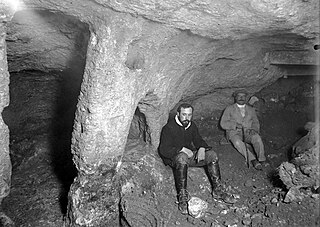
Montagu Brownlow Parker, 5th Earl of Morley was a British aristocrat and army officer. He became famous for the eponymous expedition he led to Jerusalem, which started in 1909, in which he searched for the Ark of the Covenant and other treasures for the First Temple.

Jerusalem Archaeological Park, also known as Ophel Garden, is an archaeological park established in the 1990s in the Old City of Jerusalem. It is located south of the Western Wall Plaza and under the Dung Gate. The park was managed by the Ir David Foundation until 2021, when it changed management to the Company for the Reconstruction and Development of the Jewish Quarter.

The Herodian Quarter –Wohl Archaeological Museum is an underground archaeological site and museum situated in the Jewish Quarter of the Old City of Jerusalem. It exhibits lavish residencies that reflect the high standard of living among the affluent inhabitants of Jerusalem's Upper City during the late Second Temple Period and up until the city's destruction in 70 CE.

The use of stone vessels made from soft limestone/chalkstone among Jews during the Second Temple period and beyond was widespread across Judea, Galilee and the Golan Heights. Initially appearing in the early 1st century BCE, these vessels continued to be utilized in each region for differing lengths of time.



















